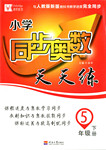题目内容
—How is Dennis getting along with his work?
—Well, he could always _____ a new idea for increasing sales.
A.call up B.bring about C.lead to D.come up with
D

 同步奥数系列答案
同步奥数系列答案Dogs have an understanding of fair play and become angry if they feel that another dog is getting a better deal, a new study has found.
The study looked at how dogs react when a companion is rewarded for the same trick in an unequal way. Friederike Range, a researcher at the University of Vienna in Austria, and her colleagues did a series of experiments with dogs who knew how to respond to the command “give the paw “. The dogs were normally happy to repeatedly give the paw, whether they got a reward or not. But that changed if they saw that another dog was being rewarded with a piece of food, while they received nothing.
“We found that the dogs hesitated significantly longer when obeying the command to give the paw,” the researchers write. The unrewarded dogs eventually stopped cooperating.
Scientists have long known that humans pay close attention to inequity. But researchers always assumed that animals didn’t share the trait. “The argument was that this is a uniquely human phenomenon,” says Frans de Waal, a professor of psychology at Emory University in Atlanta.
That changed in 2003 when he and a colleague did a study on monkeys. The monkeys had to hand a small rock to researchers to get a piece of cucumber in return. They were happy to do this. But if they saw that another monkey was getting a more delicious reward, a grape, for doing the same job, they would throw away the food and rock, and at some point just stopped performing.
In that experiment, the monkeys considered the fairness of two different types of payment. But when Range and her colleagues did a similar study with their trained dogs, testing to see if dogs would become upset if they only got dark bread when other dogs received sausage, they found that as long as the dogs got some kind of food payment, even if it wasn’t the most delicious kind, the animals would play along.
1.How did the dogs in Range’s study react to the order of “giving the paw”?
|
A.They took the order even without being rewarded. |
|
B.They took the order only when rewarded. |
|
C.They turned a deaf ear to repeated orders. |
|
D.They hesitated longer when given repeated orders. |
2. The research by Frans De Waal in 2003 ___________.
|
A.originated from Range’s research on dogs. |
|
B.showed that animals do pay attention to inequity. |
|
C.began the argument that only humans are aware of inequity. |
|
D.was conducted to find out how monkeys reacted to humans’ orders. |
3. Some monkeys in the research become angry because they found another monkey _______.
|
A.was given less work. |
|
B.was given more food. |
|
C.was given the same type of food. |
|
D.was given more delicious food. |
4. Range found that, compared with monkeys, dogs ____________.
|
A.care more about whether they are rewarded. |
|
B.care less about what they are rewarded with. |
|
C.care more about what they are ordered to do. |
|
D.care less about who gives them orders. |
5. What is the main idea of the passage?
|
A.Animals have various ways to show their anger. |
|
B.Dogs are less intelligent than monkeys. |
|
C.Dogs have a sense of fairness. |
|
D.Most animals want to be rewarded equally. |